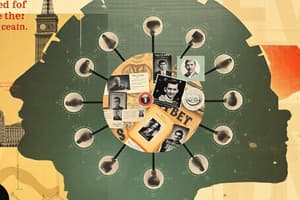Podcast
Questions and Answers
Protons and neutrons are found in the nucleus of an atom, while electrons orbit around it.
Protons and neutrons are found in the nucleus of an atom, while electrons orbit around it.
True (A)
The atomic number of an element is determined by the number of isotopes it has.
The atomic number of an element is determined by the number of isotopes it has.
False (B)
Ionic bonds are formed when atoms share electrons with each other.
Ionic bonds are formed when atoms share electrons with each other.
False (B)
Elements in the same group of the Periodic Table have similar chemical properties due to their valence electron configuration.
Elements in the same group of the Periodic Table have similar chemical properties due to their valence electron configuration.
In a balanced chemical equation, the number of atoms of each element is the same on both sides of the equation.
In a balanced chemical equation, the number of atoms of each element is the same on both sides of the equation.
Flashcards
Atomic Structure
Atomic Structure
Atoms are composed of a nucleus with protons and neutrons, surrounded by electrons.
Periodic Table Organization
Periodic Table Organization
Elements are arranged by atomic number, showing groups (columns) and periods (rows) with repeating trends.
Types of Chemical Bonds
Types of Chemical Bonds
Atoms bond to form compounds—ionic (metal+nonmetal), covalent (nonmetal+nonmetal), and metallic (metal+metal).
Chemical Reaction Types
Chemical Reaction Types
Signup and view all the flashcards
Balancing Chemical Equations
Balancing Chemical Equations
Signup and view all the flashcards




